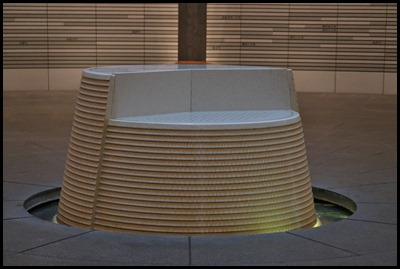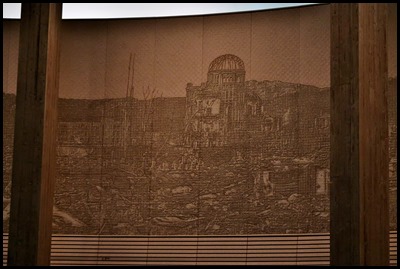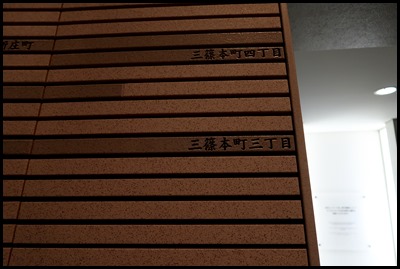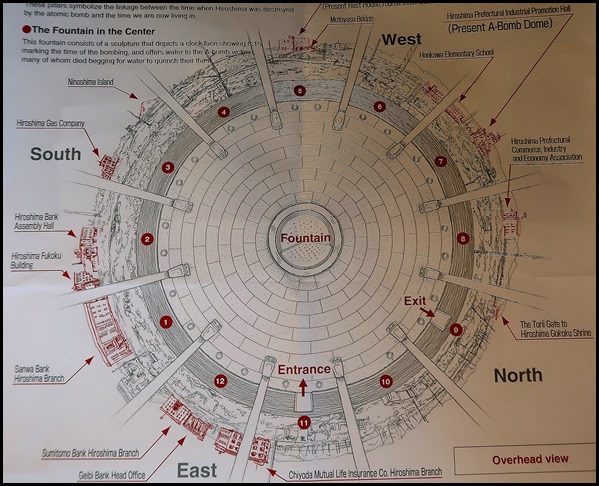Hiro Remembrance Hall

|
The Hall of Remembrance,
Hiroshima
 We were very warmly welcomed to the
Hall of Remembrance by the lady at the information counter which was
glass-topped and full of the origami cranes that have become the symbol for
peace. Please may I blog about our visit, I asked the nice lady. “Tell the
world, my dear, tell the world”.
The entrance to the walkway down to
the Hall is dominated by a plaque that reads and beyond yet another plaque:
The Hall of Remembrance is
provided for recollection of the victims, prayer for the peaceful repose of
their souls, and the contemplation of peace.
The wall is a panorama that
recreates a view of the A-bombed city as seen from Shima Hospital, the
hypocenter. The panorama is made of
140,000 tiles, the number of people estimated to have died by the end of
1945.
Looking down to the Memorial Hall, taken from above the screen.
The National
Peace Memorial Hall for the Atomic Bomb Victims is an effort by the Japanese
national government to remember and mourn the sacred sacrifice of the atomic
bomb victims. It is also an _expression_ of Japan’s desire for genuine and lasting
peace. This hall and its counterpart in Nagasaki City are designed to convey the
tragic disasters that occured in these cities to people around the world and
ensure that future generations will learn from these
experiences
The roles of the
Hiroshima National Peace Memorial
Hall for the Atomic Bomb Victims are to offer a “Hall of Remembrance”, register
the names and photographs of atomic bomb victims, collect memoirs of those who
were exposed, and advocate throughout Japan and the world the abolition of
nuclear weapons.
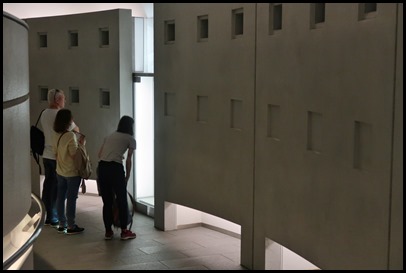 We began a slow, downward spiral and
every two panels were information boards that read:
At one point in the 20th century, Japan walked the path of war. Then, on
December 8, 1941, Japan initiated hostilities against the US, Great Britain and others, plunging into what came to be known as
the Pacific War. This war was largely fought elsewhere in the Asia Pacific
region, but when the tide turned against Japan, American warplanes began bombing
the homeland, and Okinawa became a bloody battlefield.
Within this context of war, on
August 6, 1945, the world’s first atomic weapon, a bomb of unprecedented
destructive power, was dropped on the city of Hiroshima.
The bomb dropped at 8:15 a.m.,
August 6, 1945,exploded at an altitude of approximately 600 meters over the city
of Hiroshima. It emitted heat rays, blast, and radiation. In the vicinity of the
hypocenter, heat from the bomb raised surface temperatures to 3,000 to 4,000
degrees Centigrade and generated a blast that blew 440 meters per second (about
984 miles per hour). Simultaneously, an enormous amount of radiation was
emitted. These three forms of energy instantly destroyed the entire city,
indiscriminately taking many lives.
About 350,000 people are
estimated to have been in Hiroshima when the atomic bomb was dropped. Among
these were many people from Korean peninsula, which was then a Japanese colony,
and include persons from China. Some of these had been conscripted. Also present
were foreign students from China and Southeast Asia, and American prisoners of
war.
The A-bomb devastated nearly all
administrative agencies and destroyed official documents. Thus, the exact number
of deaths due to the atomic bombing of Hiroshima remains unknown. Many victims
were never identified.
According to a document submitted
by the city of Hiroshima to the United Nations in 1976 entitled “For the
Elimination of Nuclear Weapons and the Reduction of All Armed Forces and All
Armaments,” and estimated 140,000 (+/- 10,000) people died as a result of the
A-bomb between August 6, 1945, and the end of December that
year.
The injuries inflicted by the
atomic bomb appeared to be healing by the end of 1945, but a high percentage of
those who seemed to be recovering later fell victim to a vast array of
aftereffects, including keloid scars, leukemia and other cancers. Since 1946,
thousands of people have passed away, and the pain and anxiety of many survivors
continue.
We hereby mourn those who
perished in the atomic bombing. At the same time, we recall with great sorrow
the many lives sacrificed to mistaken national policy. To ensure that no such
tragedies are ever repeated, we pledge to convey the truth of these events
throughout Japan and around the world, to pass it on to future generations, and
to build, as soon as possible, a peaceful world free from nuclear
weapons.
The Memorial Hall and simple water feature in the centre.
The walls in the Hall of Remembrance are covered with approximately 140,000 tiles. These walls symbolically express the profound tragedy inflicted on Hiroshima. The scenes depicted on the walls are a view from the former Shima Hospital, which stood at the A-bomb hypocenter approximately 200 meters northeast of this Memorial Hall. The 360 degree panorama was created based on photographs taken by the US army in October 1945. Inscribed below are the names of the 226 neighborhoods as they are known at the time of the bombing. The lower the name, the closer that neighborhood was to the hypocentre. The names of the neighborhoods are arranged in 42 rows, with six rows representing a distance of 500 meters (1,640 feet). The twelve pillars supporting the ceiling symbolize the linkage between the time when Hiroshima was destroyed by the atomic bomb and the time we are now living in.
An overhead view from our pamphlet.  What we had thought to be a water
feature is in fact: The Fountain in the Center.
The fountain consists of a sculpture that depicts a clock face showing 8:15,
marking the time of the bombing, and offers water to the A-bomb victims, many of
whom died begging for water to quench their thirst.
 We spent time sitting and reflecting, and found ourselves alone with
the very powerful imagery all around us,
literally.
   We stepped from the Hall and were in a
corridor, a huge landscape picture taken shortly
after the A-bomb.
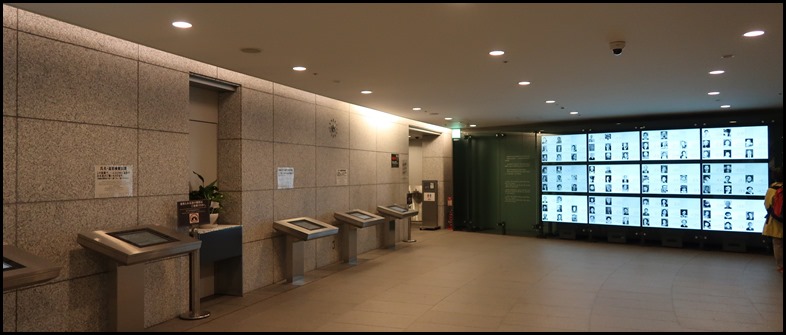 The next room presents the names and photographs of individuals who died in the
bombing. No pictures, quite rightly allowed, but I took a distant shot to show
the wall in front of us with a bank of peoples images and descriptions which
changed every thirty seconds or so and to the left computer
terminals for visitors to search for individual victims. We watched and
read for some time, so many youngsters and elderly. We did a random search and
found a five year old. Very moving.
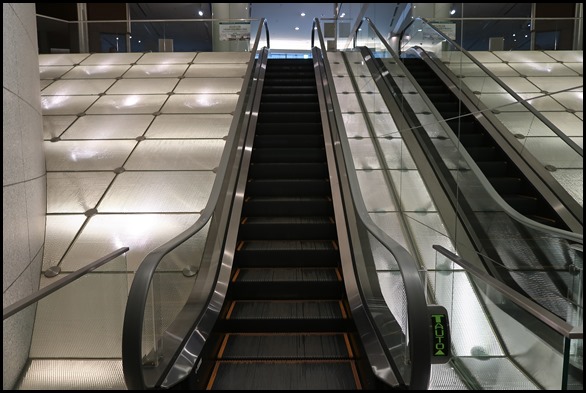 An escalator took us up to a reference library on the right
and a more computer terminals, in the centre of
the room were benches, we sat and a film came on. Cartoon-like, very simple
drawings came up that helped tell the story of several people who had, until a
quarter past eight, been going about their day-to-day routine. The one we found
most heart breaking was a lady who had been about 800 metres from the hypocenter
and assumed she would die. She went home and found her children safe but was
more relieved when many hours later her husband came home. She was happy that
her children would not be orphaned. A week later, she was still well but her
husband developed a nose bleed. By the end of the day he was dead.
 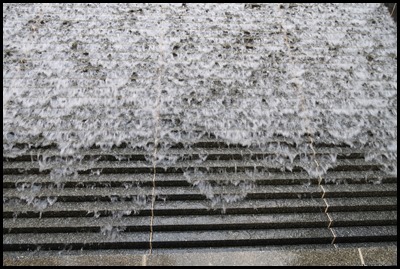 Stairs up to street level, passing a
water feature. It will be some time before we stop
associating the tinkling of water with the thirsty
victims of such a sad event in history..............
ALL IN ALL A VERY NOBLE
BUILDING
A GREAT
PRESENCE |


